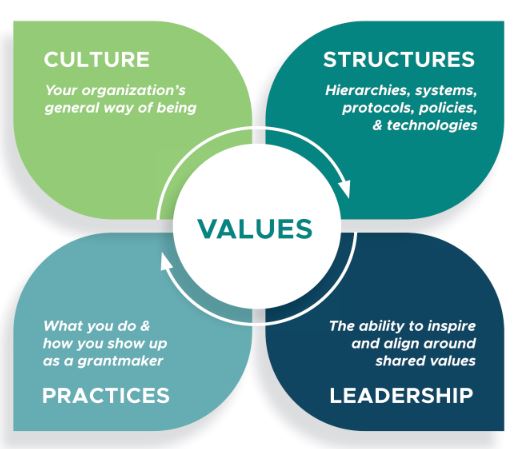Shifting To Unrestricted Grants • What we Learned
In the past few years, LVCF’s foundation-directed grantmaking strategy has been integrating “trust-based philanthropy” as a key element of how we do our work. Trust-based philanthropy seeks to demonstrate humility and collaboration in what we do and how we show up in all aspects of our work as grantmakers in our region.

We were attracted to this approach because we have taken a strong stance to learning and listening to grantees and nonprofit partners. Our work is to connect donors to causes that matter, and the only way to do that work is to understand what has gone on in the community historically, in the moment, and what might be on the horizon. However, as we entered into dialogue with nonprofit partners, we noticed that because there was an off-balance power dynamic between a typical funding institution and a nonprofit, there simply wasn’t enough trust between organizations and ourselves for organizations to tell us the full reality of what was happening within their organizations or in the field. Instead, we heard about how our funding of a particular issue was great, and how everything at the organization was operating at its highest efficiencies.
This pattern makes sense –nonprofits feel that if they are transparent with a funder, they might end up risking losing their funding. So, like any wise institution that uncovers an issue, we began to ask ourselves what part we play in setting up this dynamic, and what can we do to build more trusting relationships? We understood that if we wanted to make real impact, we needed to understand the actual reality of nonprofits and the problems that they are facing, so that we can be a genuine partner in helping address those issues. We turned towards embracing trust-based philanthropy, a common approach that was being adopted by funding institutions across the nation to address this very issue.
Integrating Trust-Based Philanthropy
Over the past few years, we have integrated trust-based philanthropy values that function as a grounding force across four key dimensions of our work including: culture, structures, practices, and leadership.
We have been championing this approach to grant unrestricted funding for several years, and as we champion this grantmaking approach, as a learning organization, we are committed to sharing what we are uncovering with our donors and fundholders.

Youth & Families Grants as a Case Study
LVCF’s Youth and Families leadership grantmaking offers a specific example of our general operating approach, what we are learning, and how it’s making impact. Over the last two fiscal years, we’ve distributed $375,000 in general operating funding to support Lehigh Valley’s youth and their families. Prior to being considered for an unrestricted grant, our staff does careful due diligence of those that apply. We ensure there is a certain level of confidence in the organization’s governance and financial oversight. We believe the greatest impact is achieved by distributing general operating funding.
This is what we experienced:
We examine organizations deeply and develop a wider lens of their operation and mission

When a funder distributes a grant for project or program-based funding, the information received, reviewed, and reported on is primarily about that specific program and/or project. In reality, organizations are running many different programs, tied to its administration function. Without asking questions about the whole organization, the funder misses important views about all programs, its operational efficiencies, its culture, its leadership, and its relationships in the community. By asking deeper and wider questions about the whole organization, we start to understand not only the impact of a particular program or project, but rather the impact of the whole organization, how it fits into the landscape of the particular area of focus, and how it aligns with our own values as a grantmaker.
We have a better understanding of the landscape and the strategic questions that partners face

Last year, in our Youth and Families report, we asked “what are the strategic questions that your organization is grappling with?” The results were enlightening and gave us insight into barriers occurring across the entire field. The reporting period was June 2022 – December 2022. During this time, organizations were starting to re-establish operations as people started to resume some normalcy after the pandemic. Organizations were trying to navigate staffing (retention, leadership development, hiring qualified staff, managing burn-out), doing the work of diversity, equity, inclusion, and belonging, and shifting their programs and services to meet the need of community given the change or deepening in complexity of issues arising post the height of the impact of COVID. Knowing this information allows us to be a better partner in leveraging our position and resources to assist in addressing barriers, or minimally gives us a good understanding of why funding is used in certain ways.
We’ve seen no frivolous spending by organizations receiving general operation funds

One of the routine concerns about granting general operating funding has been the worry that organizations might not spend it responsibly. This concern is reduced through our process of due diligence, having seen that the organization has demonstrated a responsible expenditure of funding. We prefer the approach to fund organizations that we trust will spend the dollars in the way they see best fit to achieve our mutual goals. In reviewing last year’s youth and families grant reports, there was no frivolous or questionable spending in the nearly $200,000 distributed to over 31 organizations. Common uses during this period were also related to the strategic questions that organizations were grappling with during this time. Trends included spending on expanding/shifting programs, curriculum development, to understand program evaluation to address the need the community’s issues in a post-Covid era and adjust accordingly; and staff salaries, staff development, and new staff hires to address retention and burn-out issues. These are costs that must be covered for an organization to thrive. We also believe that like all strategies, there should be some nuances. For example, to insure a statewide organization spends the funding in the Lehigh Valley, we restrict the funding to a specific area.
Part of a National Trend in Giving
Nationally, as the general operating trend continues, funders around the country are evaluating what actually happens when nonprofits receive large, unrestricted grants. There has been several evaluations published, including The Center for Effective Philanthropy’s (CEP) recent examination of MacKenzie Scott grantees, along with complementary research by Panorama Global. We’ve seen similar results in understanding the impact of our own funding in comparison to what is now being published nationally in the field.
Ultimately, what we have found is that when you prioritize trust, mutual respect, and accountability in both directions, you have a deeper understanding leading to bigger impact and the opportunity to be a true collaborator for championing positive change. We look forward to sharing more as we learn more.
ASK MEGAN | Learn more about the community investments/grants opportunities at the Lehigh Valley Community Foundation

Megan Briggs
Vice President of Community Investments
840 West Hamilton Street
Suite 310, Allentown, PA 18101
610 351-5353 Ext. 21
megan@lvcfoundation.org
